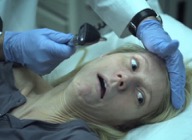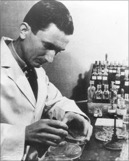Contagion is a medical thriller movie produced in 2011. The movie was directed by Steven Soderbergh and written by Scott Z. Burns. The stars of this movie include Matt Damon, Kate Winslet, Gwyneth Paltrow, and Jude Law (IMDB). Matt Damon and Gwyneth Paltrow play Beth Emhoff and Mitch Ehmoff in the movie, whom are the main characters in the movie, and are a husband and wife with the two kids.
The plot of Contagion is quite interesting – and quite terrifying. Beth Emhoff comes down with a mysterious illness after travelling home from Hong Kong on a business trip. Shortly after arriving home, Beth experiences seizure-like conditions and is rushed to the hospital by her husband, Mitch. Beth ends up dying of “unknown causes,” and the disease that she contracted during her Hong Kong visit begins to spread around the world. Mitch, being suspected of contracting the disease, is put in isolation. However, he seems to possess a gene that makes him immune to the disease and is released back home to his daughter. The next question that arises is if his daughter inherited the immunity to the disease.
The disease in the movie takes the world by storm, and eventually leaves it almost entirely apocalyptic. People begin robbing and looting as the number of deaths from the disease go rampant. The CDC is forced to take action and attempt to develop a vaccine for the disease. Through rigorous tribulations, a vaccine is developed, but it can’t meet demand. The vaccine is limited to a lottery system and allotted for certain citizens, such as first responders.
The movie Contagion is actually pretty accurate it in its depiction of its Biology-related elements. The entire concept of a disease outbreak is a biological nightmare and creating vaccines for such diseases are biological feats. The movie’s accuracy actually struck a nerve with the CDC and the public, causing them to release a program separating the “facts from fiction” within the movie-virus. The CDC program reads, “While the movie Contagion is a fictional account of an outbreak of a dangerous infectious disease occurring globally, the real-life stories of the CDC’s Epidemic Intelligence Service are just as exciting as the one on the screen…contagious disease outbreaks can and do happen. The Centers for Disease Control and Prevention investigates contagious diseases every year. They can emerge in the US or anywhere on the planet, just a plane ride away from spreading globally.”
One of the main biological plot lines in the movie is the issue of immunity and vaccines. In the movie, some people are immune to the disease because of certain alleles of genes that they possess. Vaccineinformation.org explains immunity as, “When disease germs enter your body, they start to reproduce. Your immune system recognizes these germs as foreign invaders and responds by making proteins called antibodies. These antibodies’ first job is to help destroy the germs that are making you sick. They may not act fast enough to prevent you from getting sick, but by eliminating the attacking germs, antibodies help you to get well.” In this particular movie, however, the disease kills the victim before the antibodies even have time to act, so vaccines are completely imperative to survival. Carrington College explains that a vaccine is, “…a biological preparation that improves immunity to a particular disease. It contains an agent resembling a disease-inducing microorganism – a bacterium, virus, or toxin – that activates the body’s immune system.” In the Contagion movie, developing a vaccine is the only hope in preventing a bottleneck population issue where only the immune can survive the mass outbreak.
Immunity is another key factor in the movie, adding to the dramatics. Certain people in the movie possess an allele of a gene that makes them immune to the disease, and Mitch is left to question whether his daughter inherited the immunity or not. This concept of immunity relates both to gene heredity and natural selection that we looked at in class. Since Mitch’s mother did not have the gene allele to prevent the disease and Mitch did, it is left to chance whether their daughter inherited the allele or not. This would be true for all individuals concerning the allele, making the gene naturally varying in the population. And, considering the deadly nature of the disease that it prevents, people possessing the allele are more likely to survive and are “more fit” than those who do not have the allele. Thankfully, vaccines exist to combat unknown diseases such as this, so natural selection is hindered by modern science.

Figure “Contagion (2011).” IMDB, 2011, www.imdb.com/title/tt1598778/mediaviewer/rm492927744.
Works Cited
“’Contagion’ Reality Check: CDC Experts Explore Some of the Film’s Scenarios.” PBS, Public Broadcasting Service, 23 Sept. 2011, www.pbs.org/newshour/health/cdc-experts-examine-the-science-of-hollywoods-contagion.
“Contagion: Facts Behind the Fiction.” Center for Disease Control, CDC, www2c.cdc.gov/podcasts/media/pdf/Contagion.pdf.
W., Melanie. “How Do Vaccines Work?” Carrington College, 25 Jan. 2016, carrington.edu/blog/medical/vaccines/vaccines-work/.
